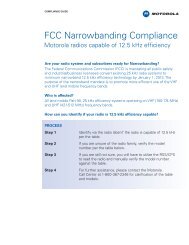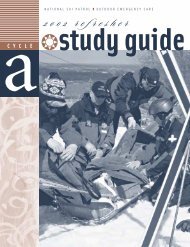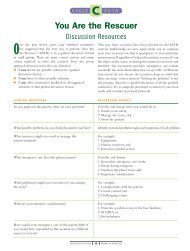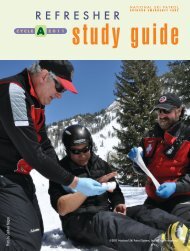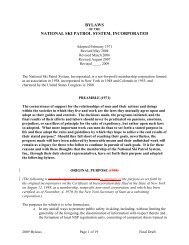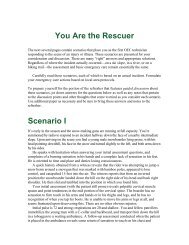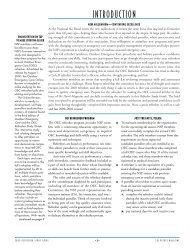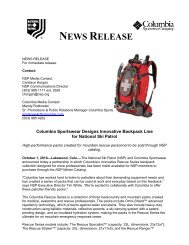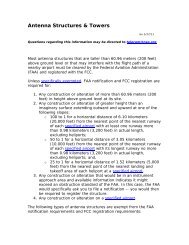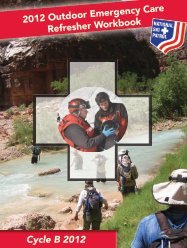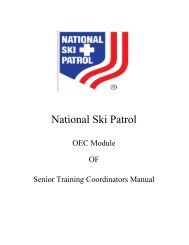Sierra Samaritans - National Ski Patrol
Sierra Samaritans - National Ski Patrol
Sierra Samaritans - National Ski Patrol
You also want an ePaper? Increase the reach of your titles
YUMPU automatically turns print PDFs into web optimized ePapers that Google loves.
avalanche & mountaineering<br />
table 2<br />
Probabilities of detection calculated for a<br />
first pass of various probe lines calculated<br />
by PROBE.<br />
Probe grid (cm) PROBE POD on first pass<br />
30x30 99.9%<br />
40x40 97%<br />
50x50 88%<br />
60x60 75%<br />
70x70 63%<br />
80x80 51%<br />
75x70 59%<br />
❚ CONTINUED FROM PAGE 45<br />
possible locations, we did our best to<br />
model a body as it might rest in all variations<br />
in the wake of an avalanche. The<br />
PROBE program generates a set of overlapping<br />
spheres to model the torso and<br />
limbs of a buried body in random orientation<br />
with consideration for the natural<br />
range of the movement of the limbs.<br />
Using averages, the victim modeled in the<br />
program is 175 cm in height and consists<br />
of about 950 spheres.<br />
After developing the model of the victim’s<br />
body, we had the computer generate<br />
a model of a snowfield and provide coordinates<br />
and dimensions for a body buried<br />
in that field. The computer was then<br />
instructed to choose a random starting<br />
point from which to begin a search for the<br />
“victim.” With the grid predetermined<br />
and held consistent at 75 by 70 cm and the<br />
victim’s location established, the program<br />
conducted a probe search across the grid<br />
until the victim was found or until the<br />
probing had clearly missed finding the<br />
body on the first pass.<br />
To test the validity of several variations<br />
of the shape and size of the target, the programmers<br />
ran 10,000 probing trials on the<br />
computer. That is, the program ran 10<br />
random starting points for probe searches<br />
for 1,000 separate victims. As shown in<br />
table 1, this model gives an even lower<br />
POD for the 75 by 70 cm grid (except in<br />
cases of vertical body orientation).<br />
We were not just interested in understanding<br />
past results and unexpected<br />
failures. We wanted to find a probing<br />
table 3<br />
table 4<br />
Expected time to discovery for various probing grids<br />
GRID DESCRIPTION (CM), HPS = HOLES PER STEP<br />
30 by 30 3HPS<br />
40 by 40 3HPS<br />
50 by 50 3HPS<br />
70 by 70 2HPS<br />
70 by 75 2HPS<br />
80 by 80 2HPS<br />
60 by 60 3HPS<br />
technique we can recommend and teach<br />
that will yield higher POD percentages<br />
for various target areas, so we started by<br />
collecting more statistics.<br />
EXPECTED TIME UNTIL<br />
DISCOVERY<br />
If first-pass POD percentages were the sole<br />
criteria for devising a probing strategy,<br />
searchers would obviously always use a 30-<br />
by 30-cm fine probe (table 2). The 99.9<br />
percent POD offers some level of assurance<br />
that the victim will be found. But at<br />
what cost? Such a time-consuming grid<br />
search would never be warranted if<br />
searchers hoped to rescue a live avalanche<br />
victim (table 3).<br />
But even when probe lines are used for<br />
recovery rather than rescue operations<br />
some thought must be given to the speed<br />
of the search in terms of the morale and<br />
well-being of the search team. Some past<br />
studies determined probing efficiency by<br />
calculating probes per area per second, but<br />
we chose instead to calculate the time it<br />
would take to find a victim by simulating<br />
how probe lines actually work.<br />
0 50 100 150 200 250 300<br />
EXPECTED TIME TO DISCOVERY (MINUTES)<br />
Comparison of several statistics for several grid sizes. (Percentages are plus or minus 1 percent.)<br />
% FOUND ON VARIOUS PASSES<br />
Technique 1st 2nd 3 or more Time per pass Average passes ETD (min.)<br />
30 cm sq. 99.9% 0.1% 0% 487 min. 0.50 244<br />
40 cm sq. 97% 2.8% 0.04% 274 min. 0.53 144<br />
50 cm sq. 88% 12.1% 0.8% 175 min. 0.64 112<br />
60 cm sq. 74% 20.8% 4.4% 122 min. 0.83 100<br />
Trad. 70x75 60% 26.5% 13.6% 96 min. 1.15 111<br />
To determine the expected time to discovery<br />
(ETD) for each size grid, our calculations<br />
called for a 20-person probe line<br />
inside a space of 10,000 square meters<br />
(1 hectare). We also used an estimate of 3.7<br />
seconds per probe, 4.4 seconds per step, a<br />
descent speed (i.e., the rate at which rescuers<br />
return to the bottom of the debris<br />
field for the second pass) of 1 second per<br />
meter, and 60 seconds for reorganization.<br />
We did our best to keep the numbers reasonable<br />
and consistent across the various<br />
trials (again, see table 3).<br />
After the first pass, we had to define<br />
what we needed to do in order to keep<br />
probing until the body was found. To<br />
maximize the probability of finding the<br />
body, the probe coordinates for the second<br />
pass were offset from the first by half<br />
of the grid dimensions. That is, after covering<br />
the standard 70 cm by 75 cm grid,<br />
the second pass was offset by 35 cm up the<br />
hill and 37.5 cm laterally for each probe<br />
step. Thus the probe holes of the second<br />
pass were exactly halfway between the<br />
holes left by the first pass.<br />
CONTINUED ON PAGE 72<br />
46 <strong>Ski</strong> <strong>Patrol</strong> Magazine | Winter 2005



